Design Thinking in Graphic Design: A Reflection on UC Orientation
VerifiedAdded on 2023/06/07
|6
|1062
|84
Essay
AI Summary
This essay delves into the concept of design thinking and its practical application in graphic design, specifically within the context of developing graphics for the UC company's orientation program. The essay begins with an introduction to design thinking as a holistic approach, emphasizing its importance in the design process. It then outlines the seven stages of design thinking: define, research, ideate, prototype, select, implement, and learn, highlighting their significance in creating effective designs. The author draws upon their past experiences in graphic design to illustrate how they have incorporated these stages, reflecting on the challenges faced and the lessons learned. The essay further discusses the importance of user research, the role of empathy, and the iterative nature of design thinking. The conclusion reiterates the value of design thinking in the evolution of design practices, emphasizing its role in creating impactful visual communication and the author's commitment to applying these principles in future projects.
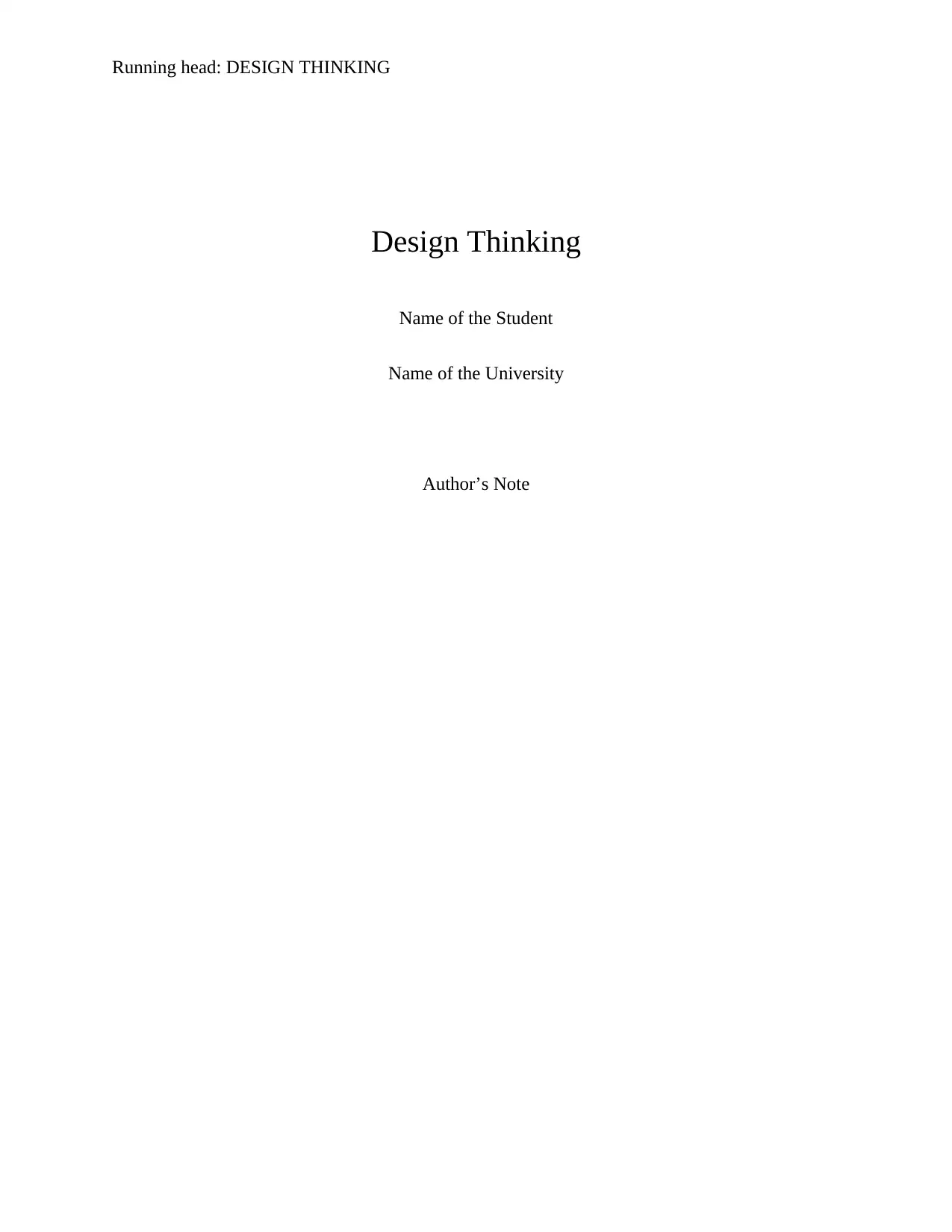
Running head: DESIGN THINKING
Design Thinking
Name of the Student
Name of the University
Author’s Note
Design Thinking
Name of the Student
Name of the University
Author’s Note
Paraphrase This Document
Need a fresh take? Get an instant paraphrase of this document with our AI Paraphraser

2
DESIGN THINKING
Abstract
This essay will focus on concept of design thinking and its components in applying design
thinking process in developing graphics for UC Company. The seven stages of design thinking
will be discussed in the essay and theories experienced by me during designing graphics in my
past. The essay will be a reflection of my past experiences in designing graphics with different
content.
DESIGN THINKING
Abstract
This essay will focus on concept of design thinking and its components in applying design
thinking process in developing graphics for UC Company. The seven stages of design thinking
will be discussed in the essay and theories experienced by me during designing graphics in my
past. The essay will be a reflection of my past experiences in designing graphics with different
content.
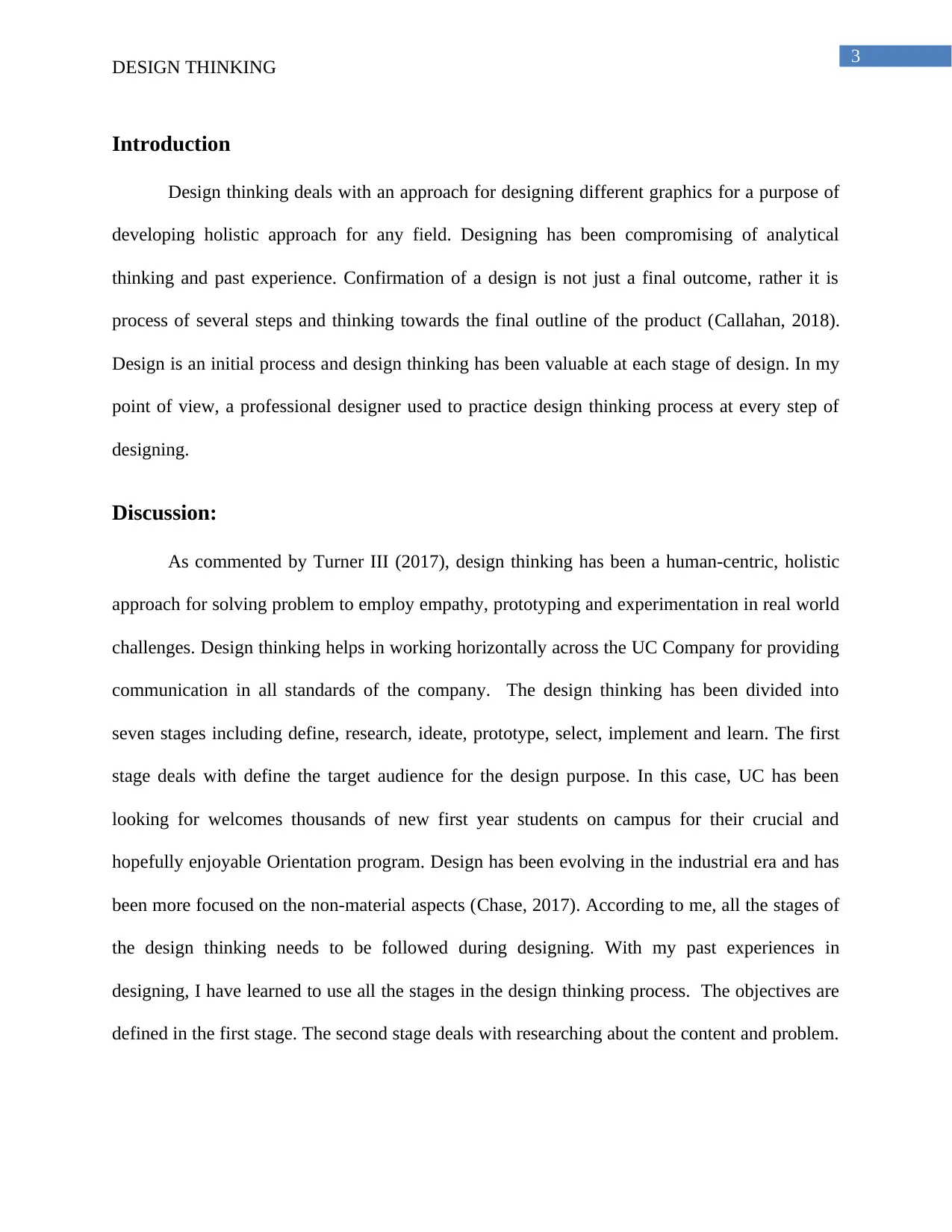
3
DESIGN THINKING
Introduction
Design thinking deals with an approach for designing different graphics for a purpose of
developing holistic approach for any field. Designing has been compromising of analytical
thinking and past experience. Confirmation of a design is not just a final outcome, rather it is
process of several steps and thinking towards the final outline of the product (Callahan, 2018).
Design is an initial process and design thinking has been valuable at each stage of design. In my
point of view, a professional designer used to practice design thinking process at every step of
designing.
Discussion:
As commented by Turner III (2017), design thinking has been a human-centric, holistic
approach for solving problem to employ empathy, prototyping and experimentation in real world
challenges. Design thinking helps in working horizontally across the UC Company for providing
communication in all standards of the company. The design thinking has been divided into
seven stages including define, research, ideate, prototype, select, implement and learn. The first
stage deals with define the target audience for the design purpose. In this case, UC has been
looking for welcomes thousands of new first year students on campus for their crucial and
hopefully enjoyable Orientation program. Design has been evolving in the industrial era and has
been more focused on the non-material aspects (Chase, 2017). According to me, all the stages of
the design thinking needs to be followed during designing. With my past experiences in
designing, I have learned to use all the stages in the design thinking process. The objectives are
defined in the first stage. The second stage deals with researching about the content and problem.
DESIGN THINKING
Introduction
Design thinking deals with an approach for designing different graphics for a purpose of
developing holistic approach for any field. Designing has been compromising of analytical
thinking and past experience. Confirmation of a design is not just a final outcome, rather it is
process of several steps and thinking towards the final outline of the product (Callahan, 2018).
Design is an initial process and design thinking has been valuable at each stage of design. In my
point of view, a professional designer used to practice design thinking process at every step of
designing.
Discussion:
As commented by Turner III (2017), design thinking has been a human-centric, holistic
approach for solving problem to employ empathy, prototyping and experimentation in real world
challenges. Design thinking helps in working horizontally across the UC Company for providing
communication in all standards of the company. The design thinking has been divided into
seven stages including define, research, ideate, prototype, select, implement and learn. The first
stage deals with define the target audience for the design purpose. In this case, UC has been
looking for welcomes thousands of new first year students on campus for their crucial and
hopefully enjoyable Orientation program. Design has been evolving in the industrial era and has
been more focused on the non-material aspects (Chase, 2017). According to me, all the stages of
the design thinking needs to be followed during designing. With my past experiences in
designing, I have learned to use all the stages in the design thinking process. The objectives are
defined in the first stage. The second stage deals with researching about the content and problem.
⊘ This is a preview!⊘
Do you want full access?
Subscribe today to unlock all pages.

Trusted by 1+ million students worldwide
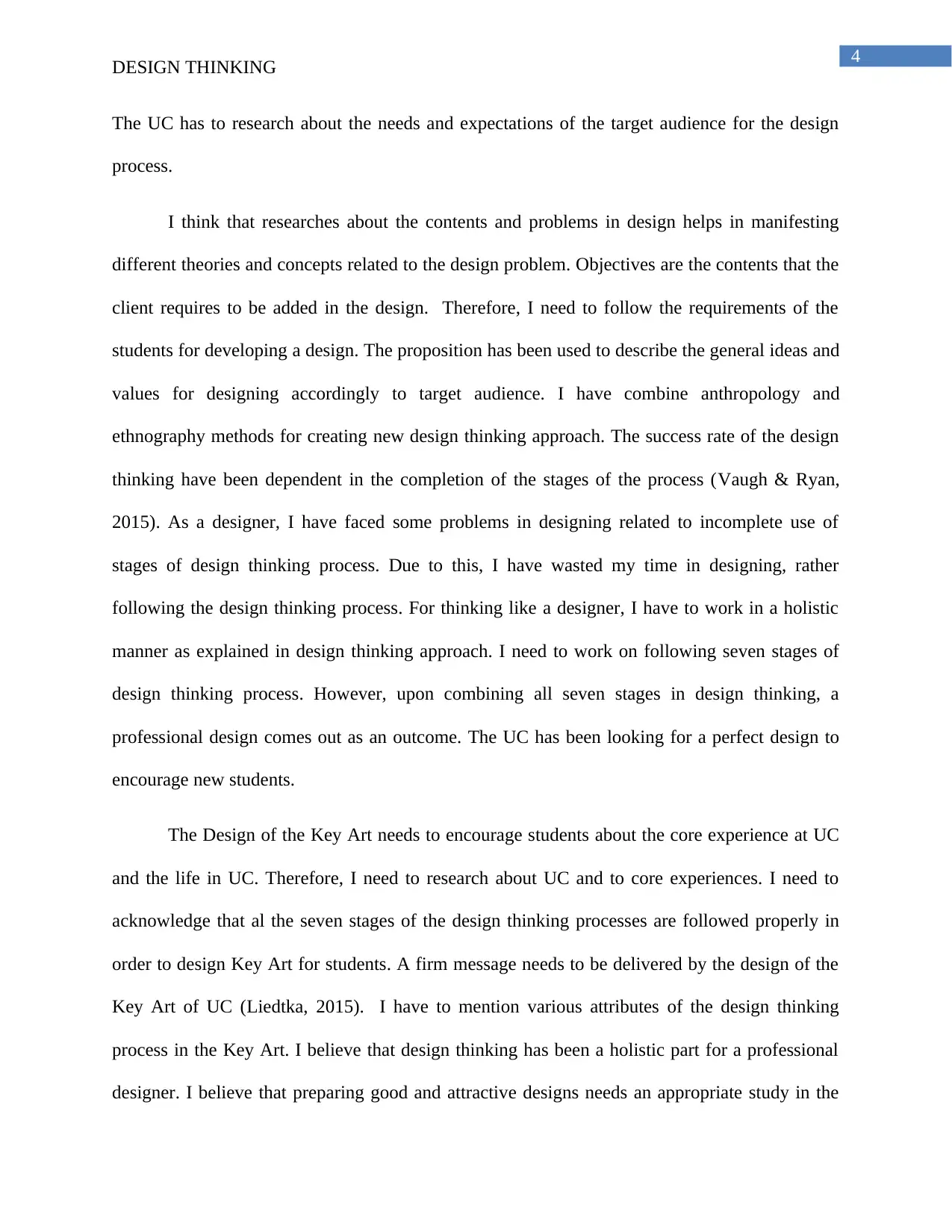
4
DESIGN THINKING
The UC has to research about the needs and expectations of the target audience for the design
process.
I think that researches about the contents and problems in design helps in manifesting
different theories and concepts related to the design problem. Objectives are the contents that the
client requires to be added in the design. Therefore, I need to follow the requirements of the
students for developing a design. The proposition has been used to describe the general ideas and
values for designing accordingly to target audience. I have combine anthropology and
ethnography methods for creating new design thinking approach. The success rate of the design
thinking have been dependent in the completion of the stages of the process (Vaugh & Ryan,
2015). As a designer, I have faced some problems in designing related to incomplete use of
stages of design thinking process. Due to this, I have wasted my time in designing, rather
following the design thinking process. For thinking like a designer, I have to work in a holistic
manner as explained in design thinking approach. I need to work on following seven stages of
design thinking process. However, upon combining all seven stages in design thinking, a
professional design comes out as an outcome. The UC has been looking for a perfect design to
encourage new students.
The Design of the Key Art needs to encourage students about the core experience at UC
and the life in UC. Therefore, I need to research about UC and to core experiences. I need to
acknowledge that al the seven stages of the design thinking processes are followed properly in
order to design Key Art for students. A firm message needs to be delivered by the design of the
Key Art of UC (Liedtka, 2015). I have to mention various attributes of the design thinking
process in the Key Art. I believe that design thinking has been a holistic part for a professional
designer. I believe that preparing good and attractive designs needs an appropriate study in the
DESIGN THINKING
The UC has to research about the needs and expectations of the target audience for the design
process.
I think that researches about the contents and problems in design helps in manifesting
different theories and concepts related to the design problem. Objectives are the contents that the
client requires to be added in the design. Therefore, I need to follow the requirements of the
students for developing a design. The proposition has been used to describe the general ideas and
values for designing accordingly to target audience. I have combine anthropology and
ethnography methods for creating new design thinking approach. The success rate of the design
thinking have been dependent in the completion of the stages of the process (Vaugh & Ryan,
2015). As a designer, I have faced some problems in designing related to incomplete use of
stages of design thinking process. Due to this, I have wasted my time in designing, rather
following the design thinking process. For thinking like a designer, I have to work in a holistic
manner as explained in design thinking approach. I need to work on following seven stages of
design thinking process. However, upon combining all seven stages in design thinking, a
professional design comes out as an outcome. The UC has been looking for a perfect design to
encourage new students.
The Design of the Key Art needs to encourage students about the core experience at UC
and the life in UC. Therefore, I need to research about UC and to core experiences. I need to
acknowledge that al the seven stages of the design thinking processes are followed properly in
order to design Key Art for students. A firm message needs to be delivered by the design of the
Key Art of UC (Liedtka, 2015). I have to mention various attributes of the design thinking
process in the Key Art. I believe that design thinking has been a holistic part for a professional
designer. I believe that preparing good and attractive designs needs an appropriate study in the
Paraphrase This Document
Need a fresh take? Get an instant paraphrase of this document with our AI Paraphraser
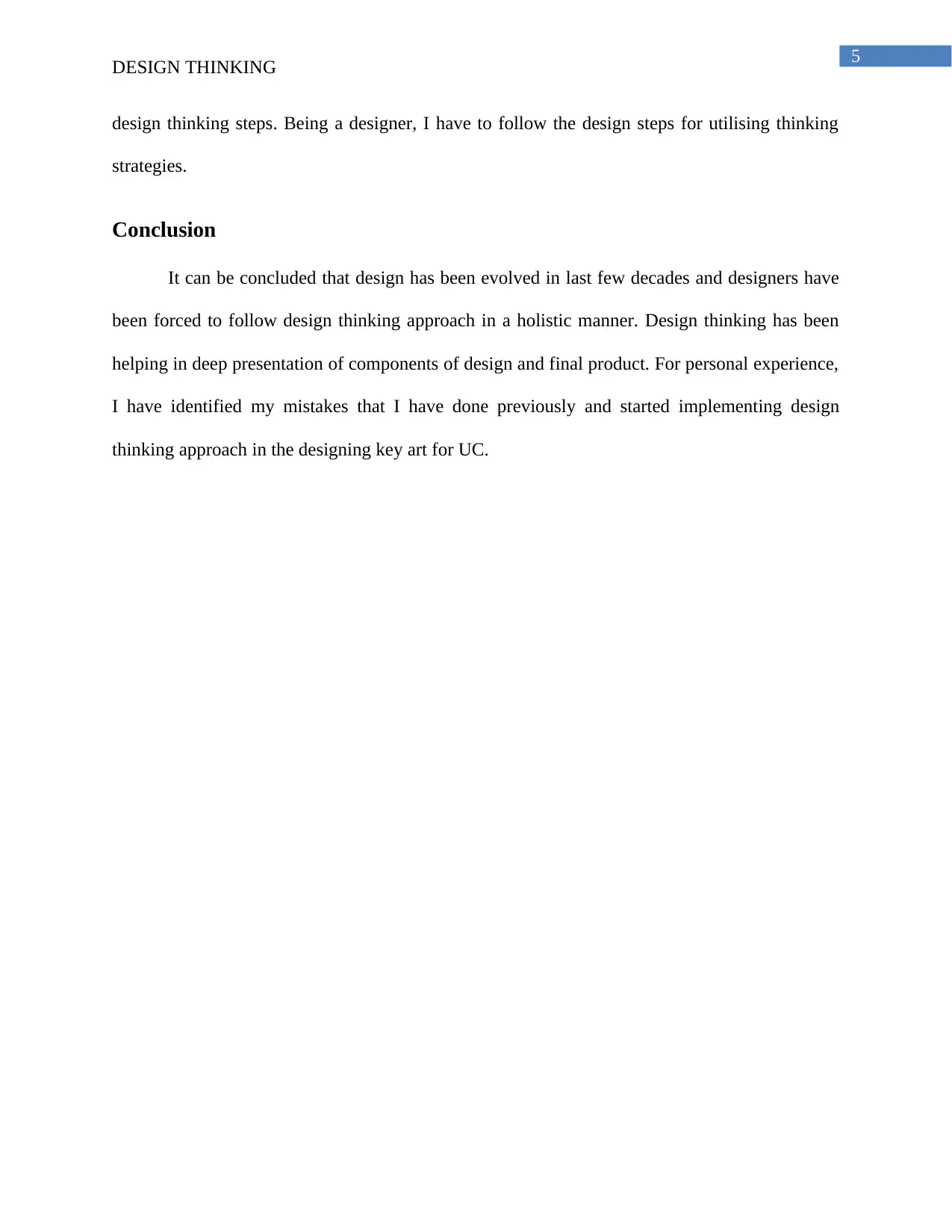
5
DESIGN THINKING
design thinking steps. Being a designer, I have to follow the design steps for utilising thinking
strategies.
Conclusion
It can be concluded that design has been evolved in last few decades and designers have
been forced to follow design thinking approach in a holistic manner. Design thinking has been
helping in deep presentation of components of design and final product. For personal experience,
I have identified my mistakes that I have done previously and started implementing design
thinking approach in the designing key art for UC.
DESIGN THINKING
design thinking steps. Being a designer, I have to follow the design steps for utilising thinking
strategies.
Conclusion
It can be concluded that design has been evolved in last few decades and designers have
been forced to follow design thinking approach in a holistic manner. Design thinking has been
helping in deep presentation of components of design and final product. For personal experience,
I have identified my mistakes that I have done previously and started implementing design
thinking approach in the designing key art for UC.
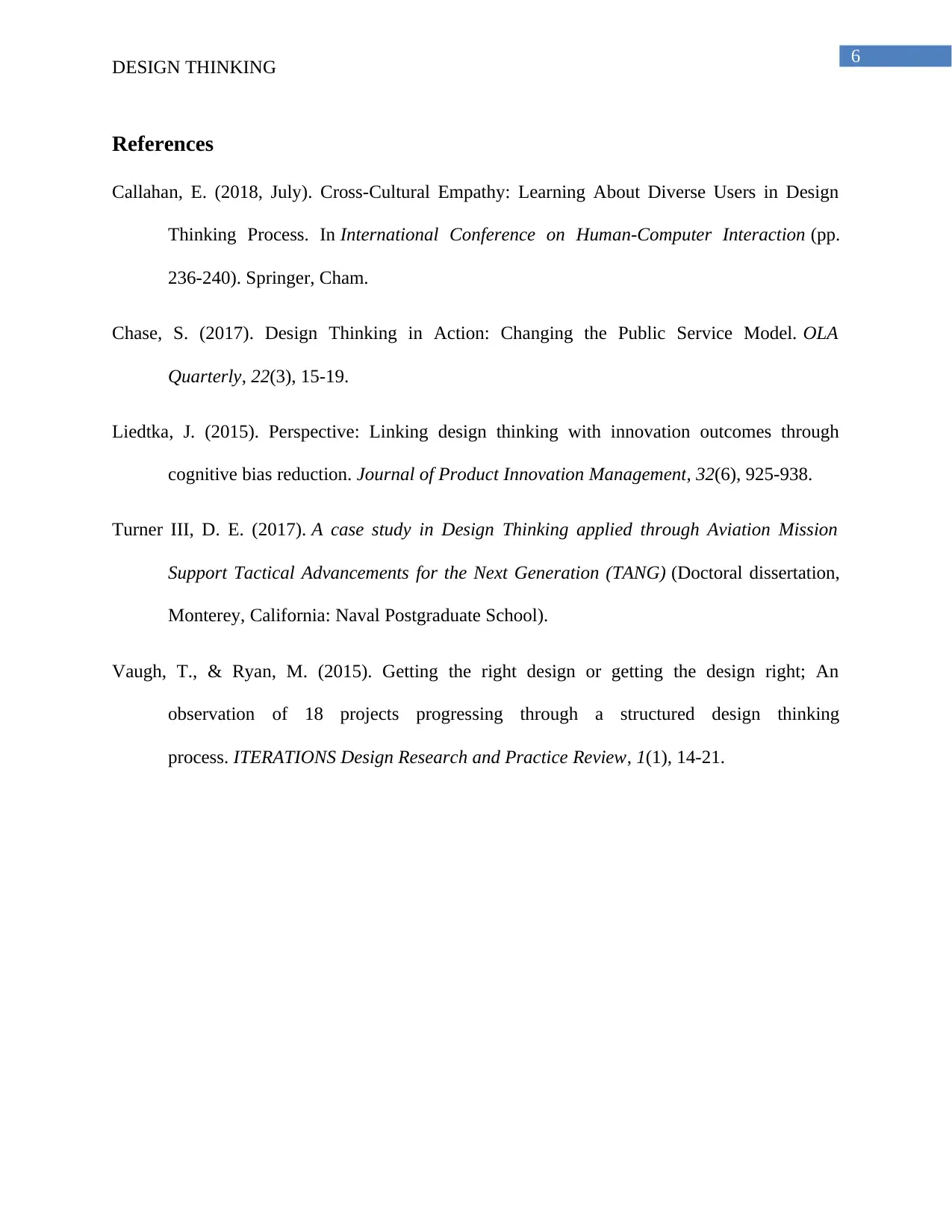
6
DESIGN THINKING
References
Callahan, E. (2018, July). Cross-Cultural Empathy: Learning About Diverse Users in Design
Thinking Process. In International Conference on Human-Computer Interaction (pp.
236-240). Springer, Cham.
Chase, S. (2017). Design Thinking in Action: Changing the Public Service Model. OLA
Quarterly, 22(3), 15-19.
Liedtka, J. (2015). Perspective: Linking design thinking with innovation outcomes through
cognitive bias reduction. Journal of Product Innovation Management, 32(6), 925-938.
Turner III, D. E. (2017). A case study in Design Thinking applied through Aviation Mission
Support Tactical Advancements for the Next Generation (TANG) (Doctoral dissertation,
Monterey, California: Naval Postgraduate School).
Vaugh, T., & Ryan, M. (2015). Getting the right design or getting the design right; An
observation of 18 projects progressing through a structured design thinking
process. ITERATIONS Design Research and Practice Review, 1(1), 14-21.
DESIGN THINKING
References
Callahan, E. (2018, July). Cross-Cultural Empathy: Learning About Diverse Users in Design
Thinking Process. In International Conference on Human-Computer Interaction (pp.
236-240). Springer, Cham.
Chase, S. (2017). Design Thinking in Action: Changing the Public Service Model. OLA
Quarterly, 22(3), 15-19.
Liedtka, J. (2015). Perspective: Linking design thinking with innovation outcomes through
cognitive bias reduction. Journal of Product Innovation Management, 32(6), 925-938.
Turner III, D. E. (2017). A case study in Design Thinking applied through Aviation Mission
Support Tactical Advancements for the Next Generation (TANG) (Doctoral dissertation,
Monterey, California: Naval Postgraduate School).
Vaugh, T., & Ryan, M. (2015). Getting the right design or getting the design right; An
observation of 18 projects progressing through a structured design thinking
process. ITERATIONS Design Research and Practice Review, 1(1), 14-21.
⊘ This is a preview!⊘
Do you want full access?
Subscribe today to unlock all pages.

Trusted by 1+ million students worldwide
1 out of 6
Related Documents
Your All-in-One AI-Powered Toolkit for Academic Success.
+13062052269
info@desklib.com
Available 24*7 on WhatsApp / Email
![[object Object]](/_next/static/media/star-bottom.7253800d.svg)
Unlock your academic potential
Copyright © 2020–2025 A2Z Services. All Rights Reserved. Developed and managed by ZUCOL.




